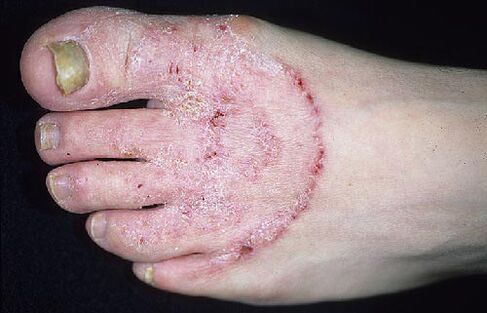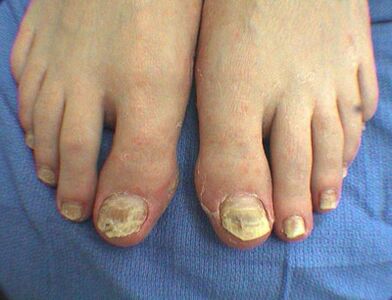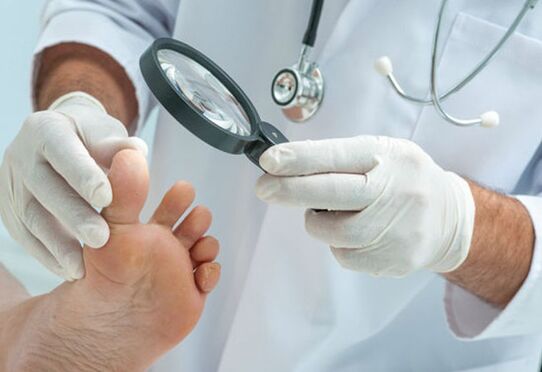Nail fungus (Onychomycosis) is the most common disease, with nails turning yellow, brittle and dense, covering cracks.In the initial stage, the symptoms of nail fungi are almost insignificant.The disease is difficult to treat due to impaired cellular immunity.The disease progresses slowly and does not have proper treatment progress and can accompany the patient for a lifetime.

Nail fungus was found in a man and a person with weak immunity.Patients with diabetes, obesity, vascular pathology, and skin diseases suffer from the disease.Legs with high sweat on the legs, skin of the feet and nails on the legs have more fungal damage.
Fungi can get nail trays from clothes, shoes, manicures, carpets, floors.It enters the nail through the microcracks of the skin and the nail bed.It is warm and humid in many places: in the soul, bathroom, dressing room and swimming pool.In healthy people, this disease rarely develops.
Causes of the disease
Thyroidosis is caused by three fungi (one or combination).Most cases of this disease are caused by mushrooms of the phospholipid type.Less frequency - hairy plant bile leaves, epidermal plant flocs and microsporidium and Aspergillus.
- Candida albican type of yeast fungus always parasitizes on the skin and nails.Taking antibiotics, birth control pills, and reduced immunity may cause yeast infections.
- Mold fungi often cause diseases in countries with tropical climates.
- Soil fungi live in the soil and cause neuropathy only in some people.There is no transmission from individual to individual.
This is the root of infection
- Diseases in family and friends can be the source of your pathogen.
The fungus is spread to the family through the use of regular towels, slippers, bedding, etc. - Fungi on the hands can be a source of nail and skin diseases.
- Fungus lives in large quantities in the bathroom, shower and swimming pool.
- The sources of infection can be the patient's clothes and shoes, manicure covers, carpets and floors.
This increases the risk of disease
- Fungus in the skin of the feet.
- Reduce immunity.
- Family members suffer from fungi failure.
- Old age.
- diabetes.
- The presence of micro hairs and burrs.
- Increases sweating in the legs.
- Unknown and poor shoes.
- The habit of walking barefoot in public places.
- Accommodation and work in humid climates.
- Wear artificial nails for a long time.
Influence the development and progress of octave bacterial disease
- Generally healthy.
- Sensitivity to infection.
- Water and heat background level.
- Type of nail plate (slower nails on fingers).

Symptoms of nail fungus
At the beginning of the disease, the usual color of the nails changes.It becomes opaque.The fungus itself appears in the gap between him and his bed.
Nails are painted in one color: white gray, yellow, green and brown until black.The yellow rectangular stripes inside and below the nails are visible.Spots of different shades.
Nails thicken and deform over the affected area.The angular mass gradually grows to prevent drug penetration.
At first, an increase in brittleness was also noted, and it began to collapse and collapse when the fungus affected the entire nail plate.During treatment, a large amount of "garbage" composed of damaged debris and epidermis is formed.Usually, the surrounding skin will be damaged.
Form of Onychomycisois
- Distal seafloor myomycosis.
- External tumor disease.
- Benign disease on white surface.
- Proximal tray mycomycosis.
- Total malnutrition myomycosis.
Distal subsea and lateral spondylosis
The form of this disease is the most common.As many as 90% of cases, the cause is mushrooms from the genus Trichophyton rubrum.Infection on the nail plate begins with the free edge of the skin of the affected foot.First, the nail bed is touched.The damage type is similar to a light yellow color of debris or stains.As the disease progresses, the nails become thicker and can be divided or separated from the skin.Distal seabed aspermia is difficult to treat.Wearing shoes can cause discomfort.
Benign white surface disease
The second most common form of dinoflagea.In 90% of cases, the disease is caused by a genus Trichophyton Interdigitale, which only affects the upper layer of the nail plate, which never thickens and is not separated from the skin.Over time, its entire surface becomes loose, just like chalk powder.The cure happens quickly.
Proximal tray mycomycosis
This form of tumor disease is rare.The red trichophyte on the blood and lymphatic pathways spread throughout the body.This is demonstrated by the damage to the nails from the back (proximal end) and by the pathogens secreted by lymph nodes and prostate in the inguinal area.The disease is usually recorded in infected HIV.The failure begins with the skin in the area of the nail folds, which thickens.In addition, the nail plates are involved in the process, which obtains a white opaque color.
Total malnutrition myomycosis
This form of the disease is the result of one or a group of forms of one or a group of types of aforementioned acetaminophycisois.The nail plate was partially or completely destroyed.
Diseases with similar symptoms

Thyroid disease was found in 50% of all infectious diseases.Similar symptoms have been found in the following diseases:
- eczema.
- psoriasis.
- Reuters syndrome.
- Daria's illness.
- Flat lichen.
- Norwegian s disease.
Diagnosing nail fungi
To obtain information about what causes certain changes, you need to consult a dermatologist who organizes procedures to diagnose the disease.Scratches from the affected section will be sent to the laboratory to clarify the cause of the disease.
Microscopy will identify the presence of fungi and seeding on nutrient medium will highlight pure cultures of pathogens and determine the sensitivity to antifungal drugs.
Before starting treatment, it is necessary to identify the type of infection.Nail fungi on the legs are easier to warn.Check the feet and nails more frequently.Initiating treatment early will help improve quickly, reduce discomfort and eliminate plastic surgery.

























